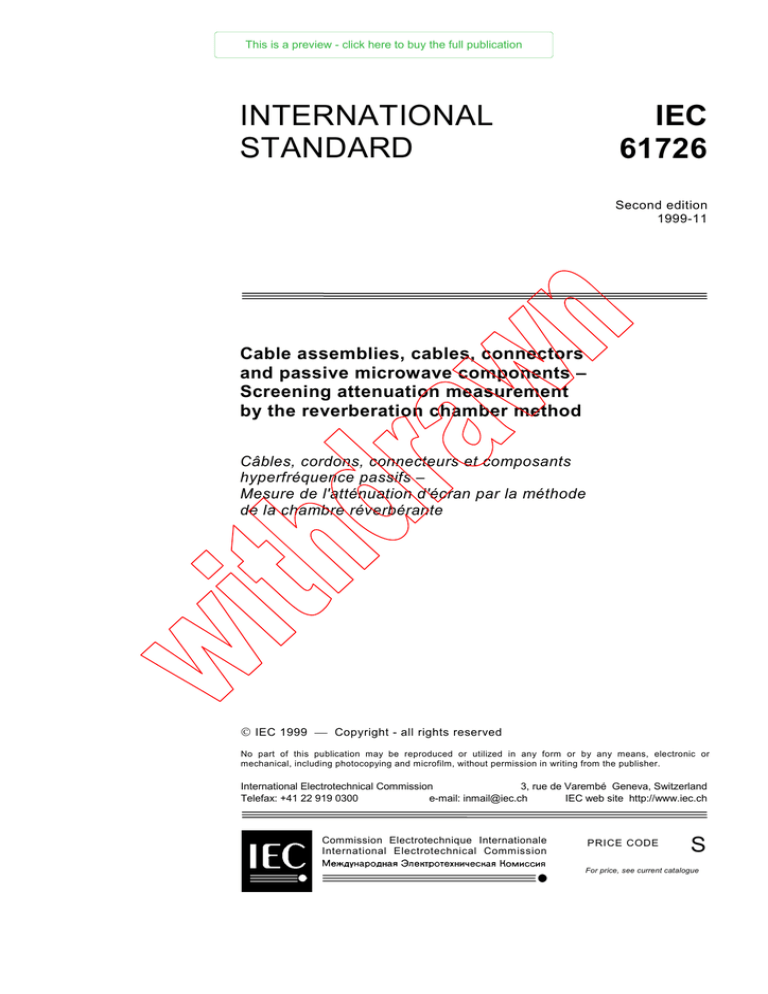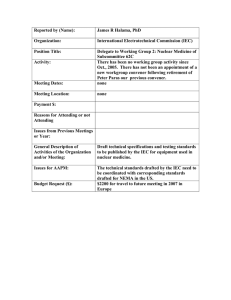
This is a preview - click here to buy the full publication
INTERNATIONAL
STANDARD
IEC
61726
Second edition
1999-11
Cable assemblies, cables, connectors
and passive microwave components –
Screening attenuation measurement
by the reverberation chamber method
Câbles, cordons, connecteurs et composants
hyperfréquence passifs –
Mesure de l'atténuation d'écran par la méthode
de la chambre réverbérante
IEC 1999 Copyright - all rights reserved
No part of this publication may be reproduced or utilized in any form or by any means, electronic or
mechanical, including photocopying and microfilm, without permission in writing from the publisher.
International Electrotechnical Commission
3, rue de Varembé Geneva, Switzerland
Telefax: +41 22 919 0300
e-mail: inmail@iec.ch
IEC web site http://www.iec.ch
Commission Electrotechnique Internationale
International Electrotechnical Commission
PRICE CODE
S
For price, see current catalogue
This is a preview - click here to buy the full publication
–2–
61726 © IEC:1999(E)
CONTENTS
Page
FOREWORD ......................................................................................................................... 3
INTRODUCTION .................................................................................................................... 5
Clause
1
Scope .............................................................................................................................. 6
2
Basic description of the reverberation chamber method .................................................... 6
3
Measurement of the screening attenuation of the device under test (DUT) ........................ 7
4
Description of the test set-up ............................................................................................ 7
5
4.1 Reverberation chamber ........................................................................................... 7
4.2 Mode stirrer ............................................................................................................ 7
4.3 Antennas ................................................................................................................ 7
4.4 Test equipment ....................................................................................................... 8
4.5 Device under test (DUT).......................................................................................... 9
4.6 Linking devices ....................................................................................................... 9
Measurement procedure................................................................................................. 10
6
5.1 General................................................................................................................. 10
5.2 Measurement of the DUT ...................................................................................... 10
5.3 Measurement of the insertion loss of the cavity...................................................... 10
5.4 Control of the test set-up ....................................................................................... 11
5.5 Revolution speed of the mode stirrer ..................................................................... 12
5.6 Test frequencies ................................................................................................... 12
5.7 Voltage standing wave ratio (VSWR) ..................................................................... 12
Evaluation of the test results .......................................................................................... 12
6.1
6.2
6.3
Screening attenuation ........................................................................................... 12
Relationship between transfer impedance parameters and screening attenuation... 13
Electromagnetic field surrounding the DUT ............................................................ 14
Annex A (informative)
Design of the reverberation chamber ................................................ 15
Annex B (informative)
Design of the mode stirrer ................................................................ 16
Annex C (informative)
Example of a calibrator..................................................................... 18
Annex D (informative) Relationship between transfer impedance and
screening attenuation ........................................................................................................... 20
Bibliography ......................................................................................................................... 22
This is a preview - click here to buy the full publication
61726 © IEC:1999(E)
–3–
INTERNATIONAL ELECTROTECHNICAL COMMISSION
___________
CABLE ASSEMBLIES, CABLES, CONNECTORS
AND PASSIVE MICROWAVE COMPONENTS –
SCREENING ATTENUATION MEASUREMENT
BY THE REVERBERATION CHAMBER METHOD
FOREWORD
1) The IEC (International Electrotechnical Commission) is a worldwide organization for standardization comprising
all national electrotechnical committees (IEC National Committees). The object of the IEC is to promote
international co-operation on all questions concerning standardization in the electrical and electronic fields. To
this end and in addition to other activities, the IEC publishes International Standards. Their preparation is
entrusted to technical committees; any IEC National Committee interested in the subject dealt with may
participate in this preparatory work. International, governmental and non-governmental organizations liaising
with the IEC also participate in this preparation. The IEC collaborates closely with the International Organization
for Standardization (ISO) in accordance with conditions determined by agreement between the two
organizations.
2) The formal decisions or agreements of the IEC on technical matters express, as nearly as possible, an
international consensus of opinion on the relevant subjects since each technical committee has representation
from all interested National Committees.
3) The documents produced have the form of recommendations for international use and are published in the form
of standards, technical specifications, technical reports or guides and they are accepted by the National
Committees in that sense.
4) In order to promote international unification, IEC National Committees undertake to apply IEC International
Standards transparently to the maximum extent possible in their national and regional standards. Any
divergence between the IEC Standard and the corresponding national or regional standard shall be clearly
indicated in the latter.
5) The IEC provides no marking procedure to indicate its approval and cannot be rendered responsible for any
equipment declared to be in conformity with one of its standards.
6) Attention is drawn to the possibility that some of the elements of this International Standard may be the subject
of patent rights. The IEC shall not be held responsible for identifying any or all such patent rights.
International Standard IEC 61726 has been prepared by subcommittee 46A: Coaxial cables, of
IEC technical committee 46: Cables, wires, waveguides, r.f. connectors and accessories for
communication and signalling.
This second edition cancels and replaces the first edition, which was issued as a type 3
technical report in 1995. It constitutes a technical revision and now has the status of an
International Standard.
The text of this standard is based on the following documents:
FDIS
Report on voting
46A/356/FDIS
46A/359/RVD
Full information on the voting for the approval of this standard can be found in the report on
voting indicated in the above table.
This publication has been drafted in accordance with the ISO/IEC Directives, Part 3.
Annexes A, B, C and D are for information only.
This is a preview - click here to buy the full publication
–4–
61726 © IEC:1999(E)
The committee has decided that this publication remains valid until 2005. At this date, in
accordance with the committee's decision, the publication will be
•
reconfirmed;
•
withdrawn;
•
replaced by a revised edition, or
•
amended.
This is a preview - click here to buy the full publication
61726 © IEC:1999(E)
–5–
INTRODUCTION
The requirements of modern electronic equipment have indicated a demand for a method of
testing screening attenuation of microwave components over their whole frequency range.
Convenient test methods exist for low frequencies and components of regular shape and these
test methods are described in the relevant product specifications.
For higher frequencies and for components of irregular shape a new test method has become
necessary and such a test method is described in this International Standard.
This is a preview - click here to buy the full publication
–6–
61726 © IEC:1999(E)
CABLE ASSEMBLIES, CABLES, CONNECTORS
AND PASSIVE MICROWAVE COMPONENTS –
SCREENING ATTENUATION MEASUREMENT
BY THE REVERBERATION CHAMBER METHOD
1
Scope
This International Standard describes the measurement of screening attenuation by the
reverberation chamber test method, sometimes named mode stirred chamber, suitable for
virtually any type of microwave component and having no theoretical upper frequency limit. It is
only limited toward low frequencies due to the size of the test equipment, which is frequency
dependent and is only one of several methods of measuring screening attenuation.
For the purpose of this standard, examples of microwave components are waveguides, phase
shifters, diplexers/multiplexers, power dividers/combiners etc.
2
Basic description of the reverberation chamber method
The reverberation chamber method for measurement of the screening attenuation of
microwave components consists of exposing the device under test (DUT) to an almost
homogeneous and isotropic electromagnetic field and then measuring the signal level induced
into the device.
These conditions are achieved by the use of a shielded enclosure, which acts as an oversized
cavity (in terms of wavelength), with a high quality factor. Its boundary conditions are
continuously agitated by a rotating reflective surface (mode stirrer), mounted within the
chamber, which enables the field to approach homogeneous and isotropic conditions during
one revolution.
Electromagnetic power is fed to the chamber by means of an input or transmitting antenna.
The strength of the field inside the chamber is measured through a reference antenna. The
ratio of the injected power (input antenna) to the received power (reference antenna) is the
insertion loss of the cavity. The insertion loss is strongly frequency dependent and is also
dependent on the quality factor of the cavity.
It has been shown that, due to the isotropic field, any antenna placed inside the cavity behaves
as if its gain was unity [1] 1) , therefore no directional effect is to be expected. If the device
under test is electrically short, its screening attenuation will be directly related to usual transfer
parameters ( Z t and Z f ). If the device under test is not electrically short the screening
attenuation may still be related to Z t and Z f in some simple cases (evenly distributed leakage,
periodically distributed leakage) using summing functions derived from antenna network theory.
___________
1) Figures in square brackets refer to the Bibliography.




